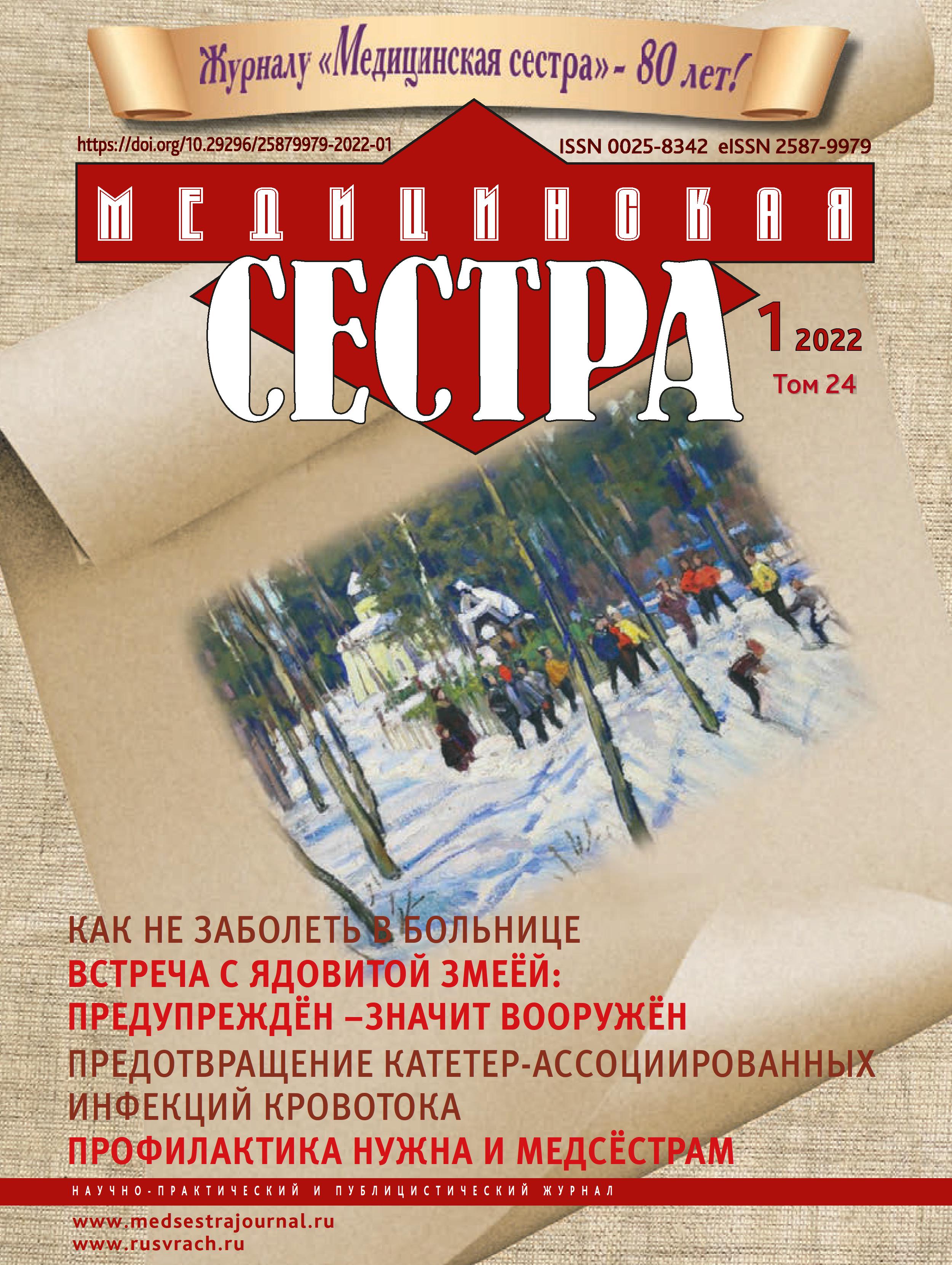Оказание медицинской помощи при укусе ядовитой змеи
- Авторы: Куценко В.П.1, Ковалева Д.Д.1, Пересада Е.И.2, Селиверстов П.В.3
-
Учреждения:
- ФГБОУ ВО «Санкт-Петербургский государственный педиатрический медицинский университет»
- АО «Северо-Западный центр доказательной медицины»
- ФГБОУ ВО «Северо-Западный государственный медицинский университет им. И.И. Мечникова»
- Выпуск: Том 24, № 1 (2022)
- Страницы: 26-35
- Раздел: Медсестре на заметку
- URL: https://journals.eco-vector.com/0025-8342/article/view/113848
- DOI: https://doi.org/10.29296/25879979-2022-01-04
- ID: 113848
Цитировать
Полный текст
Аннотация
Смертность от укусов гадюк среди взрослого населения колеблется в пределах 2-12%, у детей она еще выше – около 25%. По данным НИИ скорой помощи им. И.И. Джанелидзе ежегодно за помощью обращаются в среднем от 7 до 12 человек, при этом отмечаются отравления змеиным ядом со смертельным исходом. Смертность после укуса гадюки обыкновенной составляет около 1 % от общего числа пострадавших.
По механизму действия яды всех змей подразделяют на три группы, и связано это с их составом. Змеиные яды имеют сложный состав, помимо экзотоксинов, белков со специфическими свойствами (нейротоксическим, гемолитическим, кардиотоксическим), в них содержатся ферменты, определяющие видовую специфичность змеиного яда. В составе яда содержатся протеазы, гиалуронидаза, ферменты активаторы трипсина и тромбина, обладающие калликреинподобным действием.
К настоящему времени установлены механизмы действия многих токсинов змеиных ядов (кротоксин; каудоксин; виперотоксин; кротамин; сериновые протеазы; термолабильные белки; бета-бунгаротоксин; мохаветоксин; текстилотоксин; тайпоксин; нотексин); показано, что они изменяют активность ферментов, рецепторов или ионных каналов, нарушая, таким образом, нормальное функционирование центральной или периферической нервной системы, сердечно-сосудистой системы, мышечной системы, системы свертывания и гемостаза.
Многие виды змей содержат в одном яде токсины различных типов воздействия.
Основное токсическое действие яда гадюки обыкновенной обусловлено наличием в нем гиалуронидазы, фосфолипазы-А2 и протеолитические ферменты.
При попадании в ткани такого яда происходит развитие обширных геморрагических отеков, обусловленных как сосудистой и тканевой проницаемостью, так и нарушением в коагуляционном потенциале крови. Реакция организма на укус сопровождается высвобождением гистамина, брадикинина, простагландинов и серотонина. Высвобождение биологически активных веществ приводит к нарушению сосудистой проницаемости и падению ОЦК, со снижением системного АД. Одной из тяжелых коагулопатий на фоне укуса змеями этих семейств является развитие диссеминирующего внутрисосудистого свертывания крови с типичными полиорганными поражениями. Возможно развитие кортикального или тубулярного некроза почек. И если вовремя не будет оказана медицинская помощь, человек может умереть. С практической деятельности в медицине принято определять опасность змеи не из степени токсичности яда, а в соответствии с категориями опасности. А объединенный опыт профессиональных герпетологов и медиков позволил выработать очень простые правила первой помощи.
Ключевые слова
Полный текст
Об авторах
Валерий Петрович Куценко
ФГБОУ ВО «Санкт-Петербургский государственный педиатрический медицинский университет»
Email: val9126@mail.ru
ORCID iD: 0000-0001-9755-1906
кандидат мед. наук, доцент кафедры современных методов диагностики и радиолучевой терапии им. профессора Рейнберга
Россия,Дарья Дмитриевна Ковалева
ФГБОУ ВО «Санкт-Петербургский государственный педиатрический медицинский университет»
Email: dasha753k@gmail.com
ORCID iD: 0000-0002-6236-4526
студент
Россия,Екатерина Игоревна Пересада
АО «Северо-Западный центр доказательной медицины»
Email: ekaterina.bezvulyak@mail.ru
ORCID iD: 0000-0003-1809-4597
начальник испытательной лаборатории
Россия,Павел Васильевич Селиверстов
ФГБОУ ВО «Северо-Западный государственный медицинский университет им. И.И. Мечникова»
Автор, ответственный за переписку.
Email: seliverstov-pv@yandex.ru
ORCID iD: 0000-0001-5623-4226
кандидат медицинских наук, доцент кафедры внутренних болезней, клинической фармакологии и нефрологии
Россия,Список литературы
- Амелехина О.Е., Алтуеян В.Л., Афанасьев В.В. и др. Отравления ядами змей. - СПб.: Изд-во НИИХ СПбГУ, 2004. -86 с.
- Атяшева Т.Н., Маленев А.Л., Гореолв Р.А. и др. Возрастные различия свойств ядовитого секрета у гадюк Волжского бассейна // Вестн. Санкт-Петербург. ун-та. Сер. 3. Биология. 2016. Вып. 3. С. 14 - 18.
- Бабаханян Р.В., Ливанов Г.А., Сосюкин А.Е. и др. Отравления чдами кадюки (клиника, диагностика и лечение). Методические рекомендации. - СПб., 1999. - 15 с.
- Ганузин В.М. Классификация, клинические симптомы и неотложная медицинская помощь на догоспитальном этапе при укусе ядовитых змей // Практическая медицина. - Том 19, № 2. 2021. - С. 39 - 42.
- Горелов Р.А. Ядовитые змеи Самарской области и свойства их ядов. - Тольятти: Кассандра, 2017. - 124 с.
- Зайцева О.В. Полипептидный состав ядовитого секрета некоторых видов гадюк // Экологический сборник 2: Тр. молодых ученых Поволжья. Тольятти: ИЭВБ РАН; «Кассандра», 2009. С. 226 - 229.
- Зайцева О.В. Популяционные особенности ядовитого секрета обыкновенной гадюки Vipera berus (Linnaeus, 1758) в Волжском бассейне: Диссертация, канд. биол. наук. Тольятти: ИЭВБ РАН, 2011. 108 с.
- Зобнин Ю.В. Неотложная помощь при отравлениях ядами растительного и животного происхождения. Альманах сестринского дела. 2011; 4(1-2): 13 - 26.
- Карамышев А.М. Развитие синдрома полиорганной недостаточности у ребенка после укуса гадюки // Проблемы здоровья и экологии. - 2016. - № 3. - С. 102-108.
- Маленев А.Л., Бакиев А.Г., Зайцева О.В., Шуршина И.В. Токсичность яда обыкновенных гадюк из различных пунктов ареала // Изв. Самар. НЦ РАН. 2007а. Т. 9, № 1. - С. 259-261.
- Маленев А.Л., Бакиев А.Г., Зайцева О.В., Шуршина И.В., Зиненко А.И. Протеолитическая активность яда обыкновенных гадюк из некоторых популяций России и Украины // Изв. Самар. НЦ РАН. 2007б. Т. 9, № 4. С. 1040 - 1044.
- Павлов О.Б. Ядовитые змеи и первая помощь при укусах змей/ О.Б. Павлов, С.С.Грачёв // Медицинский журнал. - 2013. - №3. - С.15 - 20.
- Элленхорн Метью Дж. Медицинская токсикология: диагностика и лечение отравлений у человека/ пер. с англ. Г.К. Фаизовой [и др.]. Т. 1, 2. М.: Медицина, 2003 1029 с.
- Campbell BT, Corsi JM, Boneti C, Jackson RJ, Smith SD, Kokoska Pediatric snakebites: lessons learned from 114 cases. J Pediatr Surg. 2008; 43:1338 - 1341.
- Costello MW, Heins A, Zirkin Diagnosis and management of North American snake and scorpion envenomations. EBMedicine.net. 2006; 8: 1 - 28.
- Chippaux J.P., Williams V., White J. Snake venom variability: methods of study, results and interpretation // Toxicon. 1991. V. 29. P. 1279-1303.
- Daltry J.C., Wuster W., Thorpe R.S. Diet and snake venom evolution // Nature. 1996. V. 37. P. 537-540.
- Friedlich Ch., Tu A.T. Role of metals in snake venomsfor hemorrhagic, oesterase and proteolythic activities // Biochem. Pharmacol. 1971. V. 20, № 7. P. 1549-1556.
Дополнительные файлы












